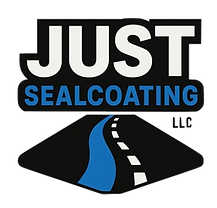Sealcoating vs. Paving: What You Need to Know
- justsealcoatingllc
- Aug 15
- 3 min read
When it comes to maintaining your driveway or parking lot, two terms often come up: sealcoating and paving. Both are essential for keeping your surfaces in good shape, but they serve different purposes. Understanding the differences can help you make informed decisions about your property.
In this post, we will explore the key aspects of sealcoating and paving, including their benefits, costs, and when to choose one over the other. By the end, you will have a clearer picture of which option is best for your needs.
What is Sealcoating?
Sealcoating is a protective layer applied to asphalt surfaces. It acts as a barrier against harmful elements like UV rays, water, and oil. Over time, these elements can cause asphalt to crack and deteriorate. Sealcoating helps to extend the life of your asphalt by preventing damage.
Benefits of Sealcoating
Protection: Sealcoating protects against weather damage, oil spills, and other harmful substances.
Aesthetic Appeal: A fresh coat of sealant gives your driveway or parking lot a clean, black finish that enhances curb appeal.
Cost-Effective: Regular sealcoating can save you money in the long run by reducing the need for costly repairs.
When to Sealcoat
Most experts recommend sealcoating every 2 to 3 years, depending on the climate and usage. If you notice cracks or fading, it may be time to apply a new layer.
What is Paving?
Paving, on the other hand, involves laying down new asphalt or concrete. This process is more extensive than sealcoating and is typically done when the existing surface is severely damaged or has reached the end of its lifespan.
Benefits of Paving
Durability: New asphalt or concrete provides a strong, durable surface that can last for many years.
Improved Functionality: Paving can fix issues like potholes and uneven surfaces, making your driveway or parking lot safer and more functional.
Increased Property Value: A well-paved surface can enhance the overall value of your property.
When to Pave
If your asphalt is cracked, crumbling, or has significant potholes, it may be time to consider paving. A professional assessment can help determine if paving is necessary.
Key Differences Between Sealcoating and Paving
Understanding the differences between sealcoating and paving is crucial for making the right choice. Here are some key points to consider:
Purpose: Sealcoating is a protective measure, while paving is a repair or replacement process.
Cost: Sealcoating is generally less expensive than paving. Sealcoating can cost between $0.15 to $0.25 per square foot, while paving can range from $2 to $5 per square foot.
Time: Sealcoating can be completed in a day, while paving may take several days, depending on the size of the area.
Cost Considerations
When deciding between sealcoating and paving, cost is often a significant factor. Here’s a breakdown of what you can expect:
Sealcoating Costs
Average Cost: $0.15 to $0.25 per square foot.
Factors Affecting Cost: Size of the area, condition of the existing surface, and local labor rates.
Paving Costs
Average Cost: $2 to $5 per square foot.
Factors Affecting Cost: Type of material (asphalt vs. concrete), size of the area, and site preparation needs.
Choosing the Right Option for Your Needs
Deciding between sealcoating and paving depends on several factors. Here are some questions to consider:
What is the condition of your surface? If it is mostly intact with minor wear, sealcoating may be sufficient. If there are significant cracks or potholes, paving might be necessary.
What is your budget? Sealcoating is more affordable, but if your surface needs extensive repairs, paving may be the better long-term investment.
How often do you use the surface? High-traffic areas may require more frequent maintenance, making sealcoating a practical choice.
Maintenance Tips for Asphalt Surfaces
Regardless of whether you choose sealcoating or paving, proper maintenance is key to extending the life of your asphalt surfaces. Here are some tips:
Regular Inspections: Check for cracks, potholes, and other damage regularly.
Prompt Repairs: Address any issues as soon as they arise to prevent further damage.
Keep it Clean: Remove debris, leaves, and oil spills promptly to avoid deterioration.
Avoid Heavy Loads: Be mindful of the weight of vehicles on your surface, especially if it is older.
The Bottom Line
Both sealcoating and paving play vital roles in maintaining your asphalt surfaces. Sealcoating is an excellent way to protect and extend the life of your existing asphalt, while paving is necessary for more severe damage.
By understanding the differences, costs, and maintenance tips, you can make informed decisions that will keep your driveway or parking lot in top shape for years to come.

In the end, whether you choose sealcoating or paving, the goal is to maintain a safe and attractive surface. Regular maintenance and timely repairs will ensure that your investment lasts.



Comments